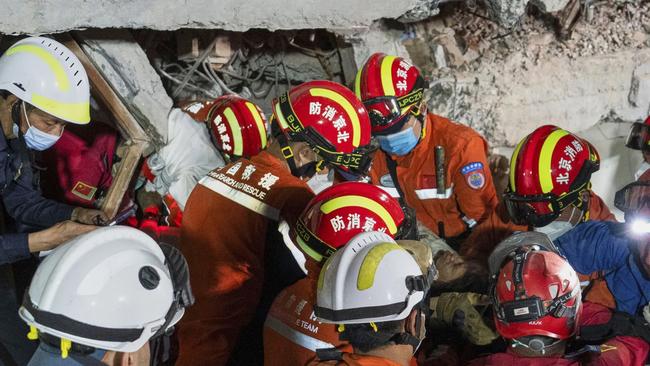In Myanmar misery, American rescuers notably absent
Notably absent from the aftermath of the magnitude-7.7 earthquake are the skilled, well-equipped and swift search-and-rescue teams and disaster-response crews from the US.

Rain is compounding misery and presenting new hurdles for relief efforts on Sunday in Myanmar, where state media reported the death toll from a devastating earthquake has risen to nearly 3500 people.
As Chinese rescue teams haul children and elderly people from collapsed buildings and Russian medical teams show off their field hospital skills, notably absent from the aftermath of the magnitude-7.7 earthquake are the skilled, well-equipped and swift search-and-rescue teams and disaster-response crews from the US.
At least 15 Asian and Western government rescue teams have landed crews reaching hundreds of workers in size, alongside initial pledges of financial aid reaching tens of millions of dollars, Myanmar's government says.
Cameras showed Vietnam's team on arrival, marching square-shouldered to the rescue behind their country's flag.
While Myanmar’s military junta and civil war pose challenges, the US government has worked with local partners there before to provide aid for decades, including after deadly storms in 2008 and 2023, aid officials say.
The American government dwarfs other nations’ rescue capacity in experience, capacity and heavy machinery able to pull people alive from rubble. But in Myanmar after the most recent quake, the US has distinguished itself for having no known presence on the ground beyond a three-member assessment team sent days after the quake.
“We all worried what would be the human impact” of President Donald Trump’s dismantling of the six-decade-old US Agency for International Development, said Lia Lindsey, a senior humanitarian policy adviser for Oxfam, which scrambled to provide tents, blankets and other aid.
“Now, we’re seeing it in real time. We’re seeing it in increased suffering, and increased death.”
A retreat from decades of American policy may be fuelling the absence. The US, the world’s largest economy, long saw its strategic interests and alliances served by its standing as the world’s top humanitarian donor.
Myanmar’s quake is as close to a no-show as the nation has had in recent memory at a major, accessible natural disaster.
Current and former senior private and government officials say the Myanmar disaster points to some of the results – for people in need on the ground, and for US standing in the world – of the Trump administration’s retreat from decades of US policy.
That approach held that Washington needed both the hard power of a strong military and the soft power of a robust aid and development program to deter enemies, win and keep friends and steer events.
Secretary of State Marco Rubio rejected a suggestion that the administration was ceding influence abroad by cancelling thousands of its aid and development contracts, including for disasters. He told reporters those complaining were the aid groups, which he accused of profiting off past US aid.
“We will do the best we can but we have other needs we have to balance that against. We’re not walking away,” Mr Rubio said, pointing to a lot of other rich countries in the world. “They should all be pitching in and do their part.”
AP





To join the conversation, please log in. Don't have an account? Register
Join the conversation, you are commenting as Logout